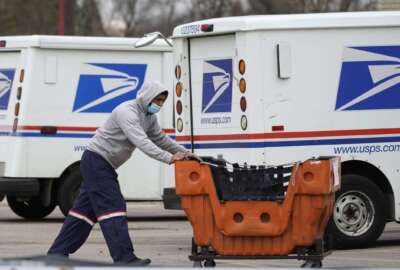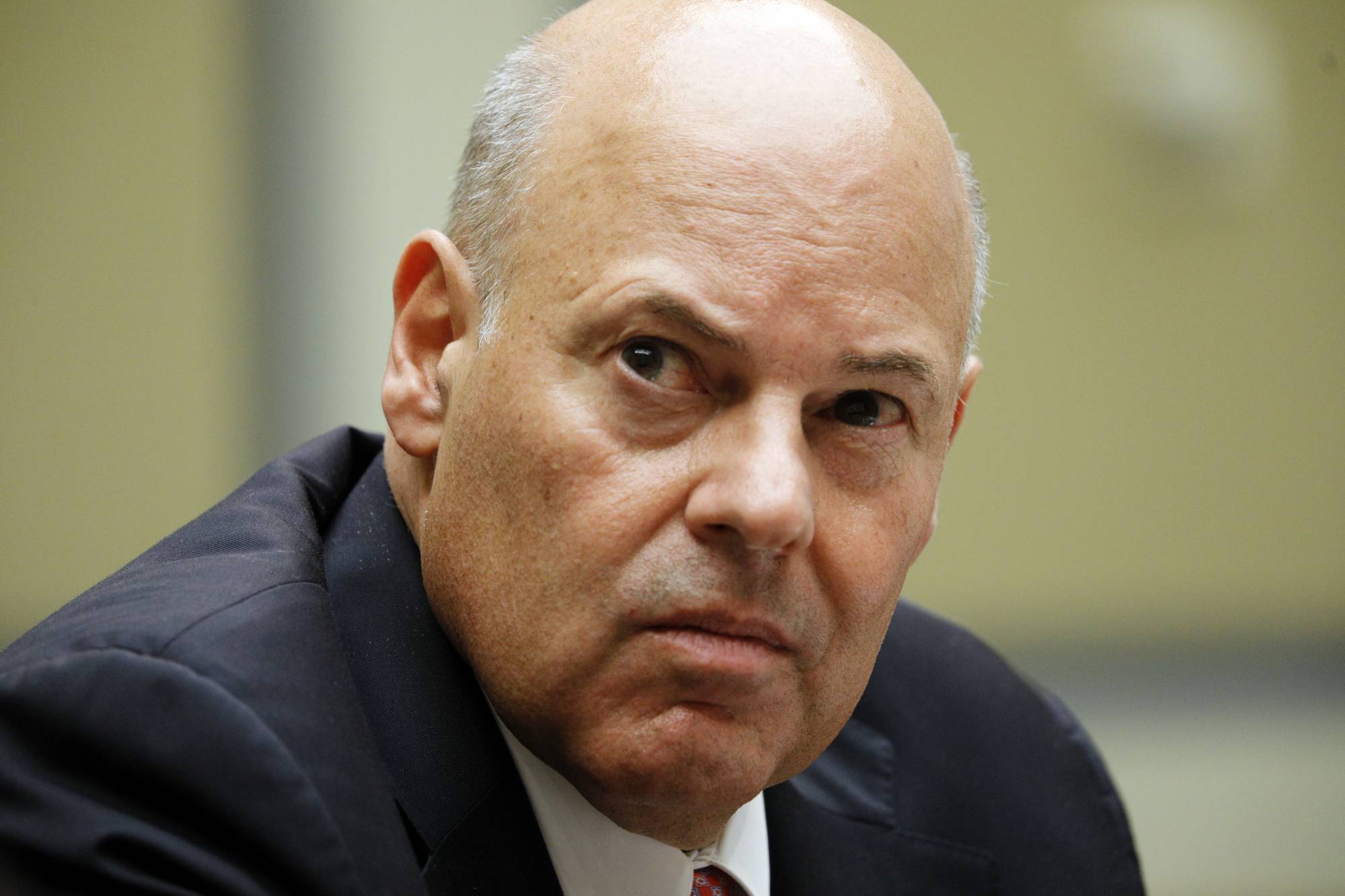DeJoy says USPS network needs ‘major’ overhaul. But union, senators wary of impact
A postal union and the head of a Senate committee overseeing USPS are pressing the agency for more details about its sweeping network changes.
Postmaster General Louis DeJoy is warning the Postal Service could run out of cash within the coming years, if it doesn’t keep up with a “major transformation” in the way it operates.
DeJoy, speaking at the Concordia U.S. Summit last month in Cary, North Carolina, said USPS will need to make the transition from “a high percent of its revenue being from its mail monopoly, to one that [needs] to compete with formidable competitors in the package delivery and retail business.”
He said institutional resistance to change within USPS, from its regulator or Congress, will lead to the agency meeting the same fate as the video rental company Blockbuster, or a long list of other businesses that failed to adapt to changing demands.
“Over time, organizations learn from their successes and from their mistakes, but rarely do they learn from their inaction or improper reaction. They just get punished — and that is what happened to the Postal Service from about 2006 until my arrival in 2020,” DeJoy said at the Nov. 7 summit.
USPS changes at an ‘accelerated pace’
But a postal union and the head of a Senate committee overseeing USPS are pressing the agency for more details about its sweeping changes.
Both inquiries focus on USPS consolidating its nationwide delivery network —and what it will mean for USPS employees and customers.
Senate Homeland Security and Governmental Affairs Committee Chairman Gary Peters (D-Mich.), in a letter sent Tuesday, is seeking additional information “on the scope of these plans and their associated impacts.”
“These changes are occurring at an accelerated pace, with new details emerging intermittently for USPS customers and employees,” Peters wrote. “I am concerned about the pace of these changes and urge USPS to provide full transparency on its plans moving forward.”
Among his questions, Peters is pressing USPS for details on “potential and actual impacts on its employees.”
At the heart of its network consolidation plans, USPS is bringing its mail processing and mail delivery operations all under one roof, in large facilities called Sorting and Delivery Centers (S&DCs).
USPS vowed in April that its network modernization won’t lead to layoffs or post office closures, even at post offices that will no longer serve as outposts for letter carrier operations.
However, the American Postal Workers Union said in October that USPS, “in a surprise announcement,” offered voluntary early retirements to its bargaining unit employees in Newark, New Jersey.
APWU said USPS isn’t offering any monetary incentive as part of the voluntary early retirements, and said the scope is limited to employees in particular crafts and jobs.
Peters is asking whether USPS expects its network changes will have any “net impact on job numbers,” including jobs reduced by attrition.
Peters is also urging USPS to communicate regularly with unions and employee groups about its plans.
“It is important to involve employees in discussions of tentative plans, before such plans are final,” he wrote.
USPS spokesman David Partenheimer told Federal News Network on Tuesday that the agency “looks forward to responding to the chairman’s letter and the opportunity to reiterate the exceptional transparency we have applied to the network modernization now well underway.”
“We do not shy away from the sense of urgency needed to modernizing the postal network for both financial and operational reasons, for survivability and to restore relevance to our customers as well as modernized and logical workplaces for our 640,000 postal workforce,” Partenheimer said.
Partenheimer added that DeJoy and USPS officials have held multiple House and Senate Committee staff briefings, spoken to committee leaders, and responded to lawmakers’ letters asking many of the same questions.
USPS has also held industry stakeholder briefings and public listening sessions, as well as released twice-a-year status updates on its 10-year Delivering for America reform plan.
Other lawmakers have also sought assurance USPS won’t close local facilities and move jobs across state lines.
Sen. Joe Manchin (D-W.V.) said in a statement last Saturday that he recently spoke to DeJoy, and that a Processing and Distribution Center (P&DC) in South Charleston “will not have one single employee laid off,” and that USPS will “instead deliver major investments to the facility to better meet the demands of the public and the market.”
APWU looks to avoid ‘negative impact’ on USPS employees
APWU is also raising several grievances regarding network modernization.
The union, so far, has filed an unfair labor practice with the National Labor Relations Board over claims USPS was not sufficiently responding to union information requests associated with the network changes. APWU said USPS has since provided some of the information it requested.
The union also filed an unfair labor practice charge with the NLRB to ensure USPS bargains with its unions over changes it’s making to the network.
The union has a major national-level grievance, claiming USPS is not upholding parts of its collective bargaining agreement with APWU when it comes to employees at risk of “excessing,” or involuntary reassignment when an employee’s position is eliminated.
APWU said USPS isn’t withholding vacant jobs as “landing spots” within 50 miles of where career employees face potential excessing.
“As management constructs new buildings, centralizes processing, and installs new automated package sortation machinery, they must do it in accordance with our union contract, and in such a way that limits the negative impact on current employees,” the union wrote.
The union said its legal department is “taking a hard look at potential court action in relation to any unlawful acts of management.”
“Changes in the mail mix, mail processing and the march of automation and technology are not new for the APWU,” APWU President Mark Dimondstein said in a statement. “We have met these challenges over many decades and will continue to meet them today. The APWU leadership is fully united in our efforts to protect our jobs, serve the people, and keep the members fully informed as these network plans unfold.”
DeJoy, in an exclusive interview this summer, spoke at length about USPS efforts to grow its business and reverse more than a decade of net losses.
USPS, however, recently reported a $6.5 billion net loss for fiscal 2023. The agency no longer expects it will “break even” in 2024, citing higher inflation and employee retirement costs than projected.
The agency also saw a recent decline in on-time mail delivery ahead of its year-end peak holiday operations.
Between Oct. 1 and Nov. 24 — the most recent data available — USPS delivered about 87.5% of first-class mail on time so far in fiscal 2024. That’s a 3.6% decrease from the fourth quarter of fiscal 2023.
USPS said the decline in on-time delivery was temporary, and was caused in part by the agency insourcing some of its logistics work from third-party contractors.
USPS said it also had shut down a facility for about two weeks in Saint Louis, Missouri, during this period, because of a hazardous mercury leak from an illegally shipped package.
The agency said the decontamination effort led to “significant rerouting of product and service disruptions throughout the Midwest.”
‘I can see some of the improvements’
Edmund Carley, national president of United Postmasters and Managers of America (UPMA), said USPS is starting to see the operational benefit from some of its S&DCs — most notably, the first one to launch in Athens, Georgia in November 2022.
“I can see some of the improvements that they wanted down there. It’s just taken a year for them to start realizing it, which is tough,” Carley said. “It’s tough on my members, because they get that pressure every day. It’s not like they do it and say, ‘We understand this is new, we’re going to leave you alone for a while.’ They’re still on you.”
USPS expects to have 30 S&DCs running by the end of this year, and about 100 S&DCs running by the end of 2024.
Carley said mail at the S&DCs is flowing “same rate or faster than it was before” at the S&DCs that are open. But it remains uncertain whether the network modernization efforts are leading to the types of cost savings DeJoy envisioned in the 10-year reform plan.
However, he said DeJoy is open to making changes if elements of the 10-year plan aren’t going as planned
“When something doesn’t work, he just quits doing it. He doesn’t keep trying to pound that square peg in a round hole,” Carley said. “He stops and says, ‘OK, that didn’t work.'”
“We open and close facilities, consolidate facilities, aggregate buildings, disaggregate buildings — that’s just what we do,” he added. “We’ve done it, probably, since [the first Postmaster General] Ben Franklin.”
‘A disruption to our plan’
Despite these recent inquiries, DeJoy has rebuffed attempts from Congress and its regulator, the Postal Regulatory Commission, to probe into elements of the 10-year reform plan.
“We do have to deliver mail and cover our costs, and everything in the organization is focused on that — and anybody or anything that tries to get in our way with that, I consider a disruption to our plan, and we’re fierce about it,” DeJoy said.
Lawmakers and the PRC, he added, didn’t do enough to put USPS on firmer financial footing between the 2008 recession — when USPS saw a major cut in mail volume that never returned — and the start of the COVID-19 pandemic in 2020.
“In an independent agency, it’s a pretty powerful position, in terms of your decision-making — and I use it. Unfortunately, in the political process that exists in Washington, it’s hard for good people to move anything forward and that’s the problem: [It’s] not the people, it’s the process,” DeJoy said.
DeJoy said that inaction from Congress and its regulator amounted to “deliberate destruction inflicted by our stakeholders.”
“These are entities that, along with the management, are responsible for ensuring that the Postal Service has the ability to serve the American people and be viable — not just to deliver mail tomorrow, but far into the future,” he said. “And when these stakeholders show a willful indifference to the negative consequences of their actions that are readily evident, I call it deliberate destruction.”
DeJoy said USPS is no longer on the verge of running out of cash in 60 days, as he said it was when he took office in 2020, but the agency still faces long-term financial challenges.
“We’re not going to run out of cash in 60 days. We’re going to turn out of cash in five years now … so there’s an urgency to that,” he said.
Copyright © 2024 Federal News Network. All rights reserved. This website is not intended for users located within the European Economic Area.
Jory Heckman is a reporter at Federal News Network covering U.S. Postal Service, IRS, big data and technology issues.
Follow @jheckmanWFED






